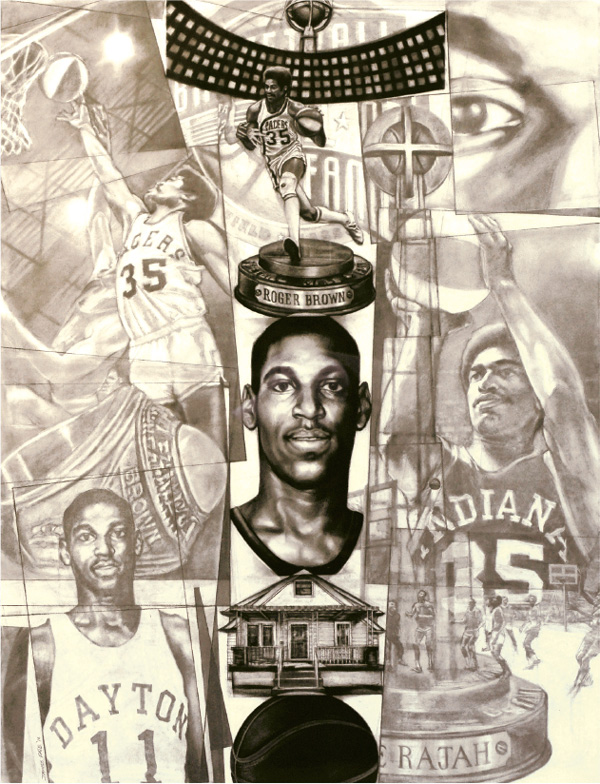Roger Brown, Dayton Flyer
Last year, Bing Davis was helping install an exhibit of work by local African American artists in the University of Dayton’s presidential residence.
 Davis, who received an honorary degree from UD in 1994, hesitated when he reached a James Pate charcoal drawing that included images such as Roger Brown in his No. 11 UD jersey, Brown soaring to the hoop as an Indiana Pacer, and the West Dayton house where Brown lived with Azariah and Arlena Smith.
Davis, who received an honorary degree from UD in 1994, hesitated when he reached a James Pate charcoal drawing that included images such as Roger Brown in his No. 11 UD jersey, Brown soaring to the hoop as an Indiana Pacer, and the West Dayton house where Brown lived with Azariah and Arlena Smith.
After his freshman year (1960-61), Brown had been banned by the NCAA and the NBA and dismissed from UD.
At UD in 1960-61, Brown joined Bill Chmielewski, Gordie Hatton, Chuck Izor and Jim Powers on the freshman team; first-year players weren’t eligible for the varsity. The team finished the season national AAU runner-up. The following season — minus Brown — the Flyers won their first NIT.
Before college, Brown had been approached by gamblers Jack Molinas and Joe Hacken. Brown was given $200 to introduce Hacken to players on New York City playgrounds, and he was allowed to drive Molinas’ car.
Investigators found Brown had no contact with either man after coming to UD and was not involved in fixing games; neither were any of the players he had introduced to the pair. Brown was never charged with anything.
“Roger was a great guy. He got a raw deal,” Chmielewski once told me.
After UD, the Smiths took Brown in. Azariah got him a job at Inland Manufacturing and a spot on that GM Division’s industrial league team. Azariah said Brown had recurring nightmares and would cry out, “Please, I didn’t do anything. Please! Please!”
Brown lived in Dayton six years before signing with the Indiana Pacers, then of the American Basketball Association. After his playing career, he became a mentor for Pacers’ players as well as a four-term Republican Indianapolis city councilman. Brown is one of four players to have his Pacers’ jersey retired. In 2013 he was enshrined in the Naismith Memorial Basketball Hall of Fame.
Before he died in 1997, I interviewed him. His breathing was labored; his voice, weak. He talked about his love for Azariah and Arlena, and he repeated one thing to me twice: “I love UD. … I still love UD.”
Davis hung the piece.
Eric F. Spina had been the UD president for just over two years. Davis told him Brown had been unjustly smeared in a gambling probe of college basketball. The NBA had lifted its ban and paid Brown a settlement.
Davis, at Spina’s home for a dinner party related to the Dayton Literary Peace Prize, gave Wil Haygood (author of Tigerland, a finalist for the 2019 prize) a tour of the exhibit. Spina noticed they had considerable conversation in front of Pate’s Roger Brown work, a piece that had become one of his favorites, too.
“It makes Roger more physical, more real,” Spina said.
Later the three men, Davis said, “were talking sports and other things, and Wil said how some of the things he was hearing about Roger paralleled the stories of some of the players on the 1968-69 Columbus East team he portrays in Tigerland.”
Spina said, “We went from, ‘Well, it’s good for Roger to be visible here in the president’s residence’ to ‘I really think it’s time to make him visible at the institution and in the community.’”
Davis agreed but didn’t get his hopes up. Over the years people — especially in West Dayton where Brown was once a cult hero — had tried to get the University to pay tribute to him.
After Brown’s death, the Smiths led a campaign in local churches, collecting signatures on a petition that was presented to the University but never acted upon.
Davis hoped this would be different.
It was.
This Nov. 5-7, UD hosted the first Roger Brown Residency in Social Justice, Writing and Sport. Wil Haygood was this year’s writer in residence.
“Roger Brown,” Spina said, “was one of the greatest basketball players ever to attend the University of Dayton, and he’s still highly regarded in the Dayton community 22 years after his death. But he has been invisible at the University of Dayton, and that is neither right nor just.”
Pate’s Roger Brown drawing found a temporary home in the UD president’s office. Spina and his wife, Karen, liked it so much they bought it.
“But my wife and I think,” Spina said, “it should be somewhere on campus.
“There are many more lessons here than him just being a good basketball player.”
Tom Archdeacon ’72 is a longtime sports writer for the Dayton Daily News, where a longer version of this story originally appeared.